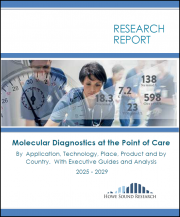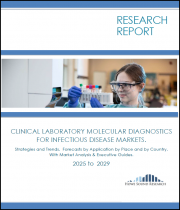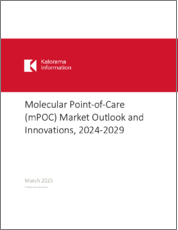
|
시장보고서
상품코드
1297778
세계의 분자진단 시장(2023-2030년)Global Molecular Diagnostics Market - 2023-2030 |
||||||
시장 개요
분자진단 세계 시장은 2022년 228억 달러, 2030년에는 357억 달러에 달할 것으로 예상되며, 수익성 있는 성장을 보일 것으로 예상됩니다. 세계 분자진단 시장은 예측 기간(2023-2030) 동안 5.9%의 CAGR을 보일 것으로 예상됩니다. 암 유병률의 증가와 다양한 응용 분야의 연구 개발의 발전이 분자진단 시장의 추세를 주도하고 있습니다.
유전자 돌연변이 식별이라고도 하는 분자진단학의 목표는 유전자 돌연변이 검출, 진단, 분류, 결과 예측, 치료 반응 추적을 용이하게 하는 것입니다. 분자진단학이라는 학문 분야는 특히 분자 유전체 기술의 큰 발전에 비추어 볼 때 임상 검사 의학, 유전체학 전문 지식 및 기술의 성공적인 상호 작용에서 탄생했습니다.
이러한 요소들은 모두 유전성 질환의 유전적 배경을 확인하고 정확하게 특성화하는 데 도움이 되며, 정확한 진단을 내리는 데 필수적입니다. 게놈 전체 관련 분석 및 차세대 시퀀싱과 같은 고처리량 기술은 질병의 원인에 대한 중요한 인사이트를 제공합니다.
분자진단 시장은 종양학, 심혈관계 질환, 감염성 질환 등의 애플리케이션으로 구성되어 분자진단 시장의 점유율을 확대하고 있습니다. 분자진단 세계 시장은 진단 기술의 발전과 각국의 향후 의료 승인 등의 요인으로 인해 확대되고 있으며, 분자진단 시장의 성장 전망도 밝게 전망되고 있습니다.
시장 역학
이러한 진단 제품들이 제공하는 수많은 장점들이 분자진단 시장의 성장을 견인
이러한 분자진단은 특이성, 민감도, 용도, 납기 등 다양한 이점을 제공합니다. 증폭 기술은 방법의 민감도를 높이고 저농도로만 존재하는 중요한 표적 분자를 식별하는 데 효과적입니다. 분자 기술은 특정 분자에 초점을 맞추기 때문에 위양성 가능성을 줄일 수 있습니다.
분자 접근법은 일반적으로 전통적인 배양 절차보다 검사 시작부터 결과 보고까지 소요되는 시간이 짧습니다. 분자 기술은 종양 마커 식별 및 모니터링, 약물 내성, 법의학, 유전자 검사, 감염성 질환 등 다양한 분야에 적용될 수 있습니다. 따라서 신제품의 우위성이 높아지면서 분자진단 시장을 주도하고 있습니다.
주요 기업의 기술 발전 증가는 제조업체에 유리한 기회를 창출
기술적으로 진보된 다양한 제품들이 대기업에 의해 개발 및 출시되고 있습니다. 현재 분자진단 기술 및 제품 유형에서 많은 발전이 이루어지고 있습니다.
또한 2023년 5월에는 결핵 원인균의 천적이자 신체의 면역체계를 피해 진화한 파지가 질병을 조기에 발견하는 데 활용될 예정입니다. 영국 최초의 파지 연구 센터는 5월 16일에 공식적으로 발표될 예정이며, Innovate UK Actiphage에서 소개될 예정입니다. 파지 기반 결핵 분자진단법은 KTN의 UK Phage Innovation Showcase에서 소개될 예정입니다.
결핵균(Mycobacterium tuberculosis, Mtb)은 DNA 방출을 차단하는 두꺼운 세포벽을 가진 박테리아로, 검출이 어렵고 배양해도 증식이 느린 것으로 알려져 있습니다. 액티파지는 Mtb에만 감염되는 바이러스인 파지를 이용해 혈액 내 살아있는 Mtb 세포를 탐색합니다. 레스터에 위치한 NIHR 호흡기 생물 의학 연구 센터의 연구에 따르면, 액티파지를 통해 혈액에서 발견된 결핵균은 활동성 결핵 질환의 징후로 볼 수 있습니다.
가짜 검사 결과가 시장 성장의 걸림돌로 작용
표현이 아닌 병원체 핵산에 의존하는 진단 분석은 여러 가지 문제로 인해 어려움을 겪습니다. 중요한 요인은 위양성 및 위음성 결과가 많다는 것입니다. 환경, 실험실, 심지어 반응 혼합물을 준비하는 도구의 DNA 오염으로 인해 질병이 잘못 식별 될 수 있으며, DNA 오염은 쉽게 제거 할 수있는 생세포 오염보다 표면이나 실험기구에서 제거하기가 더 어렵습니다.
위양성 결과는 사망을 유발하고 게놈 차원의 DNA가 샘플에 남아있는 병원성 유기체를 식별하는 데서 비롯될 수 있습니다. 이러한 상황에서 RNA는 DNA보다 내구성이 떨어지기 때문에 NASBA 및 RT-PCR과 같은 RNA 기반 절차는 분자 백업을 제공합니다. 따라서 위의 요인들이 분자진단 시장의 성장을 제한하고 있습니다.
COVID-19 영향 분석
COVID-19 팬데믹과 전 세계 각국의 봉쇄 조치로 인해 모든 산업 분야의 기업 재무 상황이 영향을 받고 있습니다. 이에 미국 식품의약국(FDA)은 COVID-19 공중보건 비상사태 기간 동안 임상시험 참여자의 안전을 보장하고, 임상시험의 무결성 위험을 최소화하기 위한 일반적인 고려사항을 포함한 가이드라인을 발표하여 임상시험 의뢰자와 연구자를 지원했습니다.
실시간 RT-PCR은 COVID-19 바이러스를 식별하는 데 가장 많이 사용되는 검사 기술 중 하나입니다. 많은 국가들이 에볼라 바이러스나 지카 바이러스와 같은 다른 질병을 진단하기 위해 실시간 RT-PCR을 채택했지만, 많은 국가들이 이 기술을 COVID-19 바이러스에 적용하고 국가의 진단 능력을 확대하기 위해 지원을 요청하고 있습니다.
러시아-우크라이나 분쟁의 영향 분석
러시아-우크라이나 분쟁은 이 지역의 주요 시장 기업 수가 적기 때문에 세계 분자진단 시장에 미치는 영향은 미미할 것으로 추정됩니다. 그러나 원자재 수입과 수출의 영향은 예측 기간 동안 분자진단 세계 시장 성장에 거의 영향을 미치지 않을 것으로 예상됩니다.
목차
제1장 조사 방법과 조사 범위
제2장 정의와 개요
제3장 주요 요약
제4장 시장 역학
- 영향요인
- 성장 촉진요인
- 이러한 진단 제품이 제공하는 수많은 이점
- POC(Point of Care) 진단약에 대한 수요 증가
- 성장 억제요인
- 잘못된 검사 결과
- 기회
- 주요 기업의 기술 진보 상승
- 영향 분석
- 성장 촉진요인
제5장 산업 분석
- Porter's 5 Force 분석
- 공급망 분석
- 가격 분석
- 규제 분석
제6장 COVID-19 분석
제7장 제품 유형별
- 시약과 키트
- 기기
- 소프트웨어와 서비스
제8장 기술별
- PCR(중합효소 연쇄 반응)
- FISH(Fluorescent In Situ Hybridization)
- 차세대 시퀸싱
- 등온 핵산 증폭 기술(INAAT)
- 기타
제9장 용도별
- 종양학
- 심혈관질환
- 감염증
- 기타
제10장 최종사용자별
- 진단 연구소
- 병원
- 기타
제11장 지역별
- 북미
- 미국
- 캐나다
- 멕시코
- 유럽
- 독일
- 영국
- 프랑스
- 이탈리아
- 스페인
- 기타 유럽
- 남미
- 브라질
- 아르헨티나
- 기타 남미
- 아시아태평양
- 중국
- 인도
- 일본
- 기타 아시아태평양
- 중동 및 아프리카
제12장 경쟁 상황
- 경쟁 시나리오
- 시장 상황/점유율 분석
- M&A 분석
제13장 기업 개요
- F. Hoffmann-la Roche Ltd
- 기업 개요
- 제품 유형별 포트폴리오와 설명
- 재무 개요
- 주요 발전
- Illumina, Inc.
- Abbott
- BD
- Bio-Rad Laboratories, Inc.
- Hologic, Inc.
- Agilent Technologies Inc.
- Myriad Genetics, Inc.
- Thermo Fisher Scientific Inc.
- Danaher
제14장 부록
ksm 23.07.11Market Overview
The Global Molecular Diagnostics Market reached US$ 22.8 billion in 2022 and is projected to witness lucrative growth by reaching up to US$ 35.7 billion by 2030. The Global Molecular Diagnostics Market is expected to exhibit a CAGR of 5.9% during the forecast period (2023-2030). The increasing prevalence of oncology and the growing research and development for various applications drive demand for molecular diagnostics market trends.
The goal of molecular diagnostics, also known as the identification of genetic variations, is to make it easier to detect, diagnose, classify, predict outcomes, and track therapeutic response. The discipline of molecular diagnostics results from the successful interaction of laboratory medicine, genomics expertise, and technology, particularly in light of substantial advancements in molecular genomic technologies.
All these elements help identify and precisely characterize the genetic underpinnings of hereditary disorders, which is essential for providing an accurate diagnosis. High-throughput techniques, such as genome-wide association analyses and next-generation sequencing, offer crucial insights into disease causes.
The Molecular Diagnostics Market scope comprises applications as oncology, cardiovascular disorders, infectious diseases and others, which has increased the molecular diagnostics market share. The global market for molecular diagnostics is expanding as a result of factors including the increasing advances in diagnostics technology and their upcoming medical approvals across countries are also creating a positive outlook for the molecular diagnostics market growth.
Market Dynamics
Numerous Advantages Provided by these Diagnostic Products drive the growth of the molecular diagnostics market.
These molecular diagnostics provide various benefits for instance, specificity, sensitivity, applications and turnaround time. Amplification techniques are beneficial for raising a methodology's sensitivity and locating target molecules of significance that only exist at deficient concentrations. Molecular techniques reduce the likelihood of false positive test findings by focusing on the particular molecule of interest.
Molecular approaches typically offer faster turnaround times from receiving to result reporting than traditional culture procedures. Molecular techniques have a wider range of applications, including in identifying and monitoring tumor markers, medication resistance, forensics, genetic testing, and infectious disorders. Hence, the growing novel products' advantages drives the molecular diagnostics market.
Rising Technological Advancements by Key Companies create lucrative opportunities for manufacturers.
A variety of technologically advanced products are being developed and launched by the major players. Numerous advancements are currently being made in molecular diagnostic technology and product type.
Furthermore, in May 2023, A phage, a natural enemy of the bacteria that causes tuberculosis and which has evolved to elude the body's immune system, is now being used to identify the illness at an early stage. The first Center for Phage Research in the UK will be formally unveiled on May 16 and highlighted in the Innovate UK Actiphage, a molecular diagnostic for tuberculosis based on phages will be featured in the UK Phage Innovation Showcase on KTN.
Mycobacterium tuberculosis (Mtb), a bacterium with a thick cell wall that blocks the release of its DNA, has proven challenging to detect and is slow to grow in culture. Actiphage searches the blood for live Mtb cells using a phage, a virus that only infects Mtb. Mtb discovered in the blood using Actiphage is a sign of active TB disease, according to research from the NIHR Respiratory Biomedical Research Centre in Leicester; this represents a possible advance in the fight to End TB.
False Test Outcomes will hamper the growth of the market.
Diagnostic assays that depend on the nucleic acids of the pathogen instead of on its phenotype are hampered by a few issues. A significant contributing factor is the high number of false positive and false negative outcomes. A disease may be mistakenly identified due to DNA contamination in the environment, the lab, and even the tools for preparing the reaction mix. DNA contamination is more difficult to remove from surfaces or lab equipment than living cell contamination, which can be easily done.
A false positive outcome could come from identifying pathogenic organisms that cause death and whose genome-wide DNA remains in the sample. Since RNA is less durable than DNA in these circumstances, RNA-based procedures like NASBA or RT-PCR provide a molecular backup. Hence these above-mentioned factors are limiting the molecular diagnostics market's growth.
COVID-19 Impact Analysis
The financial health of companies across all industries has been impacted by the COVID-19 pandemic and lockdown in numerous nations worldwide. Therefore, for the period of the COVID-19 public health emergency, the U.S. Food and Drug Administration (FDA) issued guidelines that include general considerations to aid sponsors and researchers, ensuring the safety of trial participants, adhering to good clinical practice (GCP), and minimizing risks to trial integrity.
Real-time RT-PCR is one of the most used laboratory techniques to identify the COVID-19 virus. Although many nations have employed real-time RT-PCR to diagnose other illnesses like the Ebola and Zika viruses, many still want assistance in adapting this technique for the COVID-19 virus and expanding their national diagnostic capacities.
Russia-Ukraine War Impact Analysis
The Russia-Ukraine conflict is estimated to have a low impact on the global molecular diagnostics market, owing to the low number of key market players in this region. However, the impact of the import and export of raw materials is expected to have little influence over the global molecular diagnostics market growth over the forecast period.
Segment Analysis
The Global Molecular Diagnostics Market is segmented based on product type, technology, application, end-user and region.
Instruments from the product type segment account for 37.3% of the market share owing to rising novel product launches.
Sample-to-answer instruments are designed to accept single-use cartridges with integrated Reagents and Kits that allow the detection of single or multiple targets in a patient's sample. The ideal option for mobile laboratories are diagnostic devices utilizing hermetically sealed cartridges that can withstand travel and extended storage in various climatic conditions without requiring a cold chain.
Various instruments are being launched with advanced technology. For instance, molecular biology, genomics, proteomics, and pharmacology techniques can all be accommodated by the Liquid Handling workstation known as EXTRAlab. It is distinguished by its great degree of adaptability. The workstation enables the creation of a fully automated lab to carry out sample preparation, dilution, and dispensing.
The modular design allows for simple reconfiguration to fit the customer's unique needs. For example, the liquid handling system can be modified to handle a variety of volumes and can have additional devices integrated on the basic platform.
Geographical Analysis
Due to major players' strong presence and increasing technological advancements, North America accounted for approximately 37.1% of the market share.
Manufacturers have chances to expand their operations in this region because of the rising demand for molecular diagnostics for advancements in North America. The area has many producers and suppliers, and its rapid economic development has raised industrial production of molecular diagnostics, increasing demand.
North America has a large number of producers and suppliers. As a result of the swift economic development of the area, industrial production has increased, fueling the demand of molecular diagnostics.
Rising new product types or applications will drive market growth. Growth is also fueled by rising technological advancements, regulatory approvals and novel product launches. Researchers are becoming more aware of various diagnostic approaches for cancer or other disorders, leading to expanding the market in this region. These factors shows the dominance of North America.
Competitive Landscape
The major global players in the molecular diagnostics market include: Illumina, Inc., F Hoffmann-la Roche Ltd, Abbott, Bio-Rad Laboratories, Inc., BD, Hologic Inc., Myriad Genetics, Inc., Agilent Technologies Inc., Thermo Fisher Scientific Inc. and Danaher among others.
Why Purchase the Report?
- To visualize the Global Molecular Diagnostics Market segmentation based on product type, technology, application, end-user and region, and understand key commercial assets and players.
- Identify commercial opportunities by analyzing trends and co-development.
- Excel data sheet with numerous molecular diagnostics market-level data points with all segments.
- PDF report consists of a comprehensive analysis after exhaustive qualitative interviews and an in-depth study.
- Product mapping available as Excel consisting of key products of all the major players.
The Global Molecular Diagnostics Market Report Would Provide Approximately 53 Tables, 54 Figures And 195 Pages.
Target Audience 2023
- Manufacturers/ Buyers
- Industry Investors/Investment Bankers
- Research Professionals
- Emerging Companies
Table of Contents
1. Methodology and Scope
- 1.1. Research Methodology
- 1.2. Research Objective and Scope of the Report
2. Definition and Overview
3. Executive Summary
- 3.1. Snippet by Product Type
- 3.2. Snippet by Technology
- 3.3. Snippet by Application
- 3.4. Snippet by End User
- 3.5. Snippet by Region
4. Dynamics
- 4.1. Impacting Factors
- 4.1.1. Drivers
- 4.1.1.1. Numerous Advantages Provided by these Diagnostic Products
- 4.1.1.2. Increasing Demand for Point-of-care Diagnostics
- 4.1.2. Restraints
- 4.1.2.1. False Test Outcomes
- 4.1.3. Opportunity
- 4.1.3.1. The Rising Technological Advancements by Key Companies
- 4.1.4. Impact Analysis
- 4.1.1. Drivers
5. Industry Analysis
- 5.1. Porter's 5 Forces Analysis
- 5.2. Supply Chain Analysis
- 5.3. Pricing Analysis
- 5.4. Regulatory Analysis
6. COVID-19 Analysis
- 6.1. Analysis of COVID-19
- 6.1.1. Scenario Before COVID-19
- 6.1.2. Scenario During COVID-19
- 6.1.3. Post COVID-19 & Future Scenario
- 6.2. Pricing Dynamics Amid COVID-19
- 6.3. Demand-Supply Spectrum
- 6.4. Government Initiatives Related to the Market During Pandemic
- 6.5. Manufacturers Strategic Initiatives
- 6.6. Conclusion
7. By Product Type
- 7.1. Introduction
- 7.1.1. Market Size Analysis and Y-o-Y Growth Analysis (%), By Product Type
- 7.1.2. Market Attractiveness Index, By Product Type
- 7.2. Reagents and Kits *
- 7.2.1. Introduction
- 7.2.2. Market Size Analysis and Y-o-Y Growth Analysis (%)
- 7.3. Instruments
- 7.4. Software & Services
8. By Technology
- 8.1. Introduction
- 8.1.1. Market Size Analysis and Y-o-Y Growth Analysis (%), By Technology
- 8.1.2. Market Attractiveness Index, By Technology
- 8.2. PCR (Polymerase Chain Reaction) *
- 8.2.1. Introduction
- 8.2.2. Market Size Analysis and Y-o-Y Growth Analysis (%)
- 8.3. Fluorescence In Situ Hybridization
- 8.4. Next-Generation Sequencing
- 8.5. Isothermal Nucleic Acid Amplification Technology (INAAT)
- 8.6. Others
9. By Application
- 9.1. Introduction
- 9.1.1. Market Size Analysis and Y-o-Y Growth Analysis (%), By Application
- 9.1.2. Market Attractiveness Index, By Application
- 9.2. Oncology *
- 9.2.1. Introduction
- 9.2.2. Market Size Analysis and Y-o-Y Growth Analysis (%)
- 9.3. Cardiovascular Diseases
- 9.4. Infectious Diseases
- 9.5. Others
10. By End User
- 10.1. Introduction
- 10.1.1. Market Size Analysis and Y-o-Y Growth Analysis (%), By End User
- 10.1.2. Market Attractiveness Index, By End User
- 10.2. Diagnostic Laboratories *
- 10.2.1. Introduction
- 10.2.2. Market Size Analysis and Y-o-Y Growth Analysis (%)
- 10.3. Hospitals
- 10.4. Others
11. By Region
- 11.1. Introduction
- 11.1.1. Market Size Analysis and Y-o-Y Growth Analysis (%), By Region
- 11.1.2. Market Attractiveness Index, By Region
- 11.2. North America
- 11.2.1. Introduction
- 11.2.2. Key Region-Specific Dynamics
- 11.2.3. Market Size Analysis and Y-o-Y Growth Analysis (%), By Product Type
- 11.2.4. Market Size Analysis and Y-o-Y Growth Analysis (%), By Technology
- 11.2.5. Market Size Analysis and Y-o-Y Growth Analysis (%), By Application
- 11.2.6. Market Size Analysis and Y-o-Y Growth Analysis (%), By End User
- 11.2.7. Market Size Analysis and Y-o-Y Growth Analysis (%), By Country
- 11.2.7.1. The U.S.
- 11.2.7.2. Canada
- 11.2.7.3. Mexico
- 11.3. Europe
- 11.3.1. Introduction
- 11.3.2. Key Region-Specific Dynamics
- 11.3.3. Market Size Analysis and Y-o-Y Growth Analysis (%), By Product Type
- 11.3.4. Market Size Analysis and Y-o-Y Growth Analysis (%), By Technology
- 11.3.5. Market Size Analysis and Y-o-Y Growth Analysis (%), By Application
- 11.3.6. Market Size Analysis and Y-o-Y Growth Analysis (%), By End User
- 11.3.7. Market Size Analysis and Y-o-Y Growth Analysis (%), By Country
- 11.3.7.1. Germany
- 11.3.7.2. The U.K.
- 11.3.7.3. France
- 11.3.7.4. Italy
- 11.3.7.5. Spain
- 11.3.7.6. Rest of Europe
- 11.4. South America
- 11.4.1. Introduction
- 11.4.2. Key Region-Specific Dynamics
- 11.4.3. Market Size Analysis and Y-o-Y Growth Analysis (%), By Product Type
- 11.4.4. Market Size Analysis and Y-o-Y Growth Analysis (%), By Technology
- 11.4.5. Market Size Analysis and Y-o-Y Growth Analysis (%), By Application
- 11.4.6. Market Size Analysis and Y-o-Y Growth Analysis (%), By End User
- 11.4.7. Market Size Analysis and Y-o-Y Growth Analysis (%), By Country
- 11.4.7.1. Brazil
- 11.4.7.2. Argentina
- 11.4.7.3. Rest of South America
- 11.5. Asia-Pacific
- 11.5.1. Introduction
- 11.5.2. Key Region-Specific Dynamics
- 11.5.3. Market Size Analysis and Y-o-Y Growth Analysis (%), By Product Type
- 11.5.4. Market Size Analysis and Y-o-Y Growth Analysis (%), By Technology
- 11.5.5. Market Size Analysis and Y-o-Y Growth Analysis (%), By Application
- 11.5.6. Market Size Analysis and Y-o-Y Growth Analysis (%), By End User
- 11.5.7. Market Size Analysis and Y-o-Y Growth Analysis (%), By Country
- 11.5.7.1. China
- 11.5.7.2. India
- 11.5.7.3. Japan
Australia
- 11.5.7.4. Rest of Asia-Pacific
- 11.6. Middle East and Africa
- 11.6.1. Introduction
- 11.6.2. Key Region-Specific Dynamics
- 11.6.3. Market Size Analysis and Y-o-Y Growth Analysis (%), By Product Type
- 11.6.4. Market Size Analysis and Y-o-Y Growth Analysis (%), By Technology
- 11.6.5. Market Size Analysis and Y-o-Y Growth Analysis (%), By Application
- 11.6.6. Market Size Analysis and Y-o-Y Growth Analysis (%), By End User
12. Competitive Landscape
- 12.1. Competitive Scenario
- 12.2. Market Positioning/Share Analysis
- 12.3. Mergers and Acquisitions Analysis
13. Company Profiles
- 13.1. F. Hoffmann-la Roche Ltd *
- 13.1.1. Company Overview
- 13.1.2. Product Type Portfolio and Description
- 13.1.3. Financial Overview
- 13.1.4. Key Developments
- 13.2. Illumina, Inc.
- 13.3. Abbott
- 13.4. BD
- 13.5. Bio-Rad Laboratories, Inc.
- 13.6. Hologic, Inc.
- 13.7. Agilent Technologies Inc.
- 13.8. Myriad Genetics, Inc.
- 13.9. Thermo Fisher Scientific Inc.
- 13.10. Danaher
LIST NOT EXHAUSTIVE
14. Appendix
- 14.1. About Us and Services
- 14.2. Contact Us



















